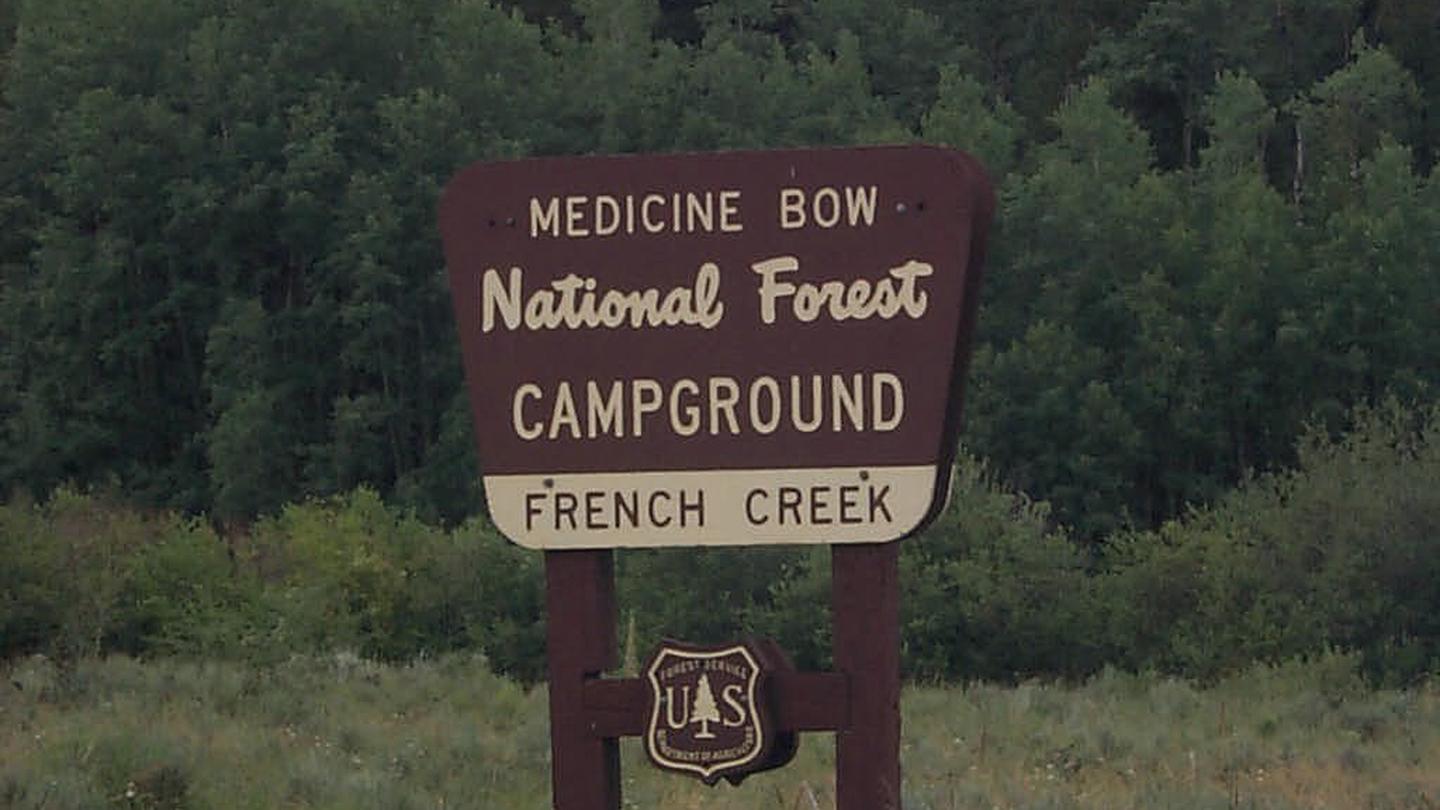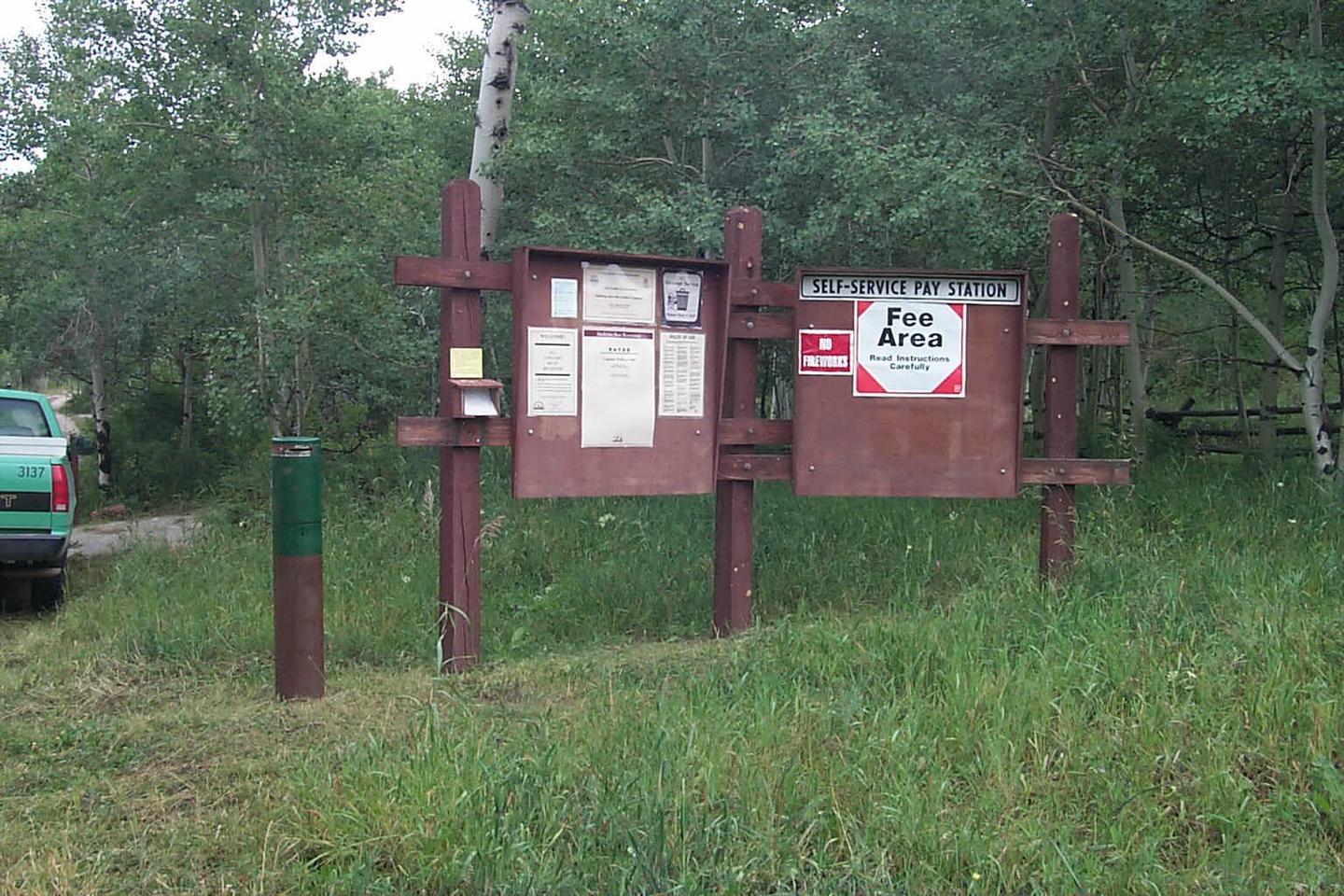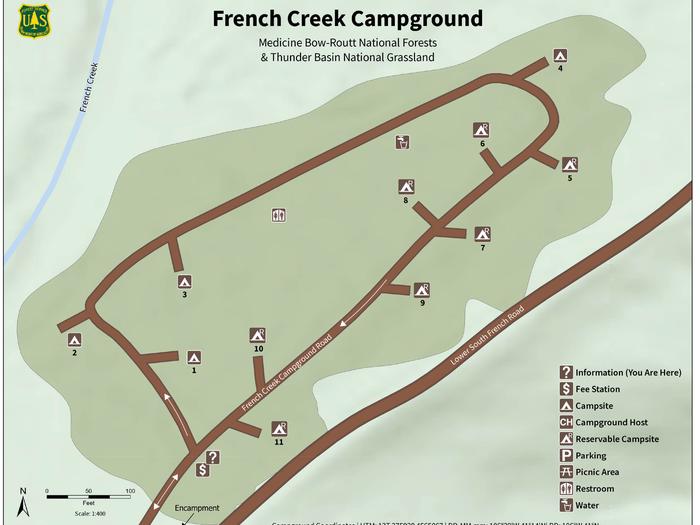French Creek Campground (WY)
Medicine Bow-Routt Nfs & Thunder Basin Ng
French Creek Campground is located on Forest Road 206. Facilities include 11 campsites (small trailers only up to 32 feet), water, picnic tables, toilets, fire grates and Trash Service is NOT Provided. Note: No water or trash services beyond mid September.)
Fishing access is available nearby in both North and South French Creeks.
The Lower Tie Hack trailhead is .25 mile east of the campground.
Need to Know
• Check-in time is after 2:00 p.m. on the first day of the reservation.
• Check-out time is 1:00 p.m. on the last day of the reservation.
• If the reservation holder doesn't show up on the first day of the reservation, the campsite is released at check-in time (2 pm) the next day.
• There are no hookup services.
• Maximum length of stay is 14 days.
• Fires are only allowed in USFS approved metal fire rings.
• Campsites are limited to 8 people and 2 vehicles per site.
• Only 1 RV/trailer per RV campsite.
• No RVs or camper trailers can park in parking spaces for walk-in tent campsites. These campsites and associated parking are for tent camping only.
• Dogs must be on leash.
• Quiet hours are 10:00 p.m. to 8:00 a.m.
• You are responsible for reading the site descriptions and booking a site that will accommodate your equipment.
• Check the elements
-What is in the skies? Check the weather report before you leave home. When you arrive at the site, keep on eye on the skies for changes and, if possible, carry a compact weather radio. In inclement weather, take shelter until the bad weather passes. Stay dry - wet clothes contribute to heat loss. Also, keep sleeping bags and important gear dry at all times.
-Are there forest or grassland alerts? Forest and grassland home pages post alerts you should know before you go. Many of our forests and grasslands also post alerts on Twitter. The latest fire information may be found on InciWeb.
Survey your surroundings
-Arrive early. Plan your trip so that you arrive at your actual campsite with enough daylight to check over the entire site and safely set up camp.
-Check for potential hazards. Be sure to check the site thoroughly for glass, sharp objects, branches, large ant beds, poison ivy, bees, and hazardous terrain.
-Avoid areas of natural hazards. Check the contour of the land and look for potential trouble spots due to rain or snow. Areas that could flood or become extremely muddy can pose a problem.
-Inspect the site. Look for a level site with enough room to spread out all your gear. A site that has trees or shrubs on the side of prevailing winds will help block strong, unexpected gusts.
-Pitch your tent in a safe spot. Make sure your tent is made of flame-retardant fabric, and keep it a safe distance away from campfires. Keep insects out of your tent by closing the entrance quickly when entering or leaving.
-Build fires in a safe area. Your open fires and fuel-burning appliances must be far enough away from the tent to prevent ignition from sparks, flames, and heat. Never use a flame or any other heating device inside a tent. Check to know whether there are fire restrictions in place before starting a campfire. You could be fined if you start a fire in a restricted area.
Be fire safe
-Keep fires small and bring firewood purchased in the local area. Firewood brought from another area could also bring invasive pests.
-If you have to collect firewood at your campsite, collect dead and down wood only.
-Check at the local ranger station for current fire restrictions, which can change on a daily, sometimes hourly, basis.
-Use existing fire rings. Scrape away litter and any other burnable material within a 10-foot-diameter surrounding the ring.
-Make sure all wood fits inside the fire ring. Do not feed a large log into the fire ring.
-Have a shovel, axe, and bucket of water available before lighting your campfire.
-Never leave a campfire unattended, even for a few minutes or even if there are no flames present. Many wildfires start because of abandoned fires or because someone thought a fire was out.
-Put out a campfire by slowly pouring water onto the fire and stirring with a shovel. Continue adding and stirring until all material is cool to touch.
-Do not bury your fire. The coals can smolder and re-ignite.
Be bear aware
Being outdoors means being with wildlife. Many people never encounter a bear. But if you do, here's some simple advice:
DO NOT RUN.
*Remain calm.
*Group together and pick up small children.
*Continue to face the bear and back away slowly, talking calmly to identify yourself as a human.
*If the bear continues to approach, try to scare it away by making yourself as large and imposing as possible by stretching your arms overhead and making loud noises.
*Carry and know how to use bear spray, which is available at many outdoor retailers and can be used to deter a charging bear.
Food Storage
Bears are always searching for food. Bears are curious, intelligent animals that have great memories. Their eyesight is similar to humans and their sense of smell is seven times more powerful than a blood hound’s, enabling them to smell food from miles away. Those are the very traits that can sometimes get them – and us – into trouble. Most bears are wary of humans and try to avoid them. However, bears can learn to associate people with food and be tenacious in their pursuit of something to eat. Even if humans are around.
Everyone in bear country must do our part to store food and other attractants in bear-resistant containers at all times, and dispose of trash in bear-resistant dumpsters.
Recreation
The Snowy Range offers endless recreational activities for any kind of visitor. Specifically, the Snowy Range contains a network of hiking trails suitable for day hiking and for extended, backcountry trips. Additionally, Streams and over 100 lakes in the area provide a variety of challenging recreational-fishing opportunities in the area. Popular attractions near this campground include Silver Lake, Lake Marie Falls, Mirror Lake, Medicine Bow Peak Trail, French Creek Canyon Trail and Miners Cabin Trail. Winter activities in the area include snowshoeing and skiing.
Mountain Biking
Areas for Mountain Biking at Snowy Range Area
• Bow River Campground
• Deep Creek Campground
• French Creek Campground
• French Creek Canyon Trail
• Keystone Cabins
• Lake Owen Trailhead
• Little Brooklyn Guard Station
• Little Laramie Trailhead
• North Fork Campground
• Pinkham Mountain Trailhead
• Rock Creek Trailhead
• Sheep Lake Trailhead
• Snow Survey Cabin
• Spruce Mountain Fire Lookout
• Tie Hack Lower Trailhead
• Tie Hack Upper Trailhead
• Tipple Trail Trailhead
Mountain Climbing
Areas for Mountain Climbing at Snowy Range Area
• Lewis Lake Picnic Site
• Libby Lake Picnic Site
Day Hiking
Areas for Day Hiking at Snowy Range Area
• Brooklyn Lake Campground
• Brush Creek Trails
• Chimney Park Trailhead
• Corner Mountain Trailhead
• Crater Lake Trailhead
• Deep Creek Campground
• Deep Lake Trail
• Dipper Lake Trail
• French Creek Campground
• French Creek Canyon Trail
• Green Rock Parking Lot
• Green Rock Picnic Site
• Keystone Cabins
• Lake Owen Trailhead
• Lakes Trailhead
• Lewis Lake Picnic Site
• Libby Lake Picnic Site
• Little Brooklyn Guard Station
• Little Laramie Trailhead
• Meadow Falls Trailhead
• Miner's Cabin Trailhead
• North Fork Campground
• Platte River Wilderness
• Quealy Lake Trailhead
• Rock Creek Trailhead
• Routt Access Trailhead
• Ryan Park Campground
• Savage Run Wilderness
• Sheep Lake Trailhead
• Silver Lake Campground
• Silver Lake Trailhead
• Six Mile Trailhead
• Snow Survey Cabin
• South Brush Creek Campground
• Spruce Mountain Fire Lookout
• Sugarloaf Campground
• Tie Hack Lower Trailhead
• Tie Hack Upper Trailhead
• Tipple Trail Trailhead
• West Lake Marie
Backpacking
Areas for Backpacking at Snowy Range Area
• Crater Lake Trailhead
• Deep Lake Trail
• Dipper Lake Trail
• Lakes Trailhead
• Lewis Lake Picnic Site
• Libby Lake Picnic Site
• Platte River Wilderness
• Quealy Lake Trailhead
• Rock Creek Trailhead
• Savage Run Wilderness
• Sheep Lake Trailhead
• Six Mile Trailhead
Viewing Wildlife
Areas for Viewing Wildlife at Snowy Range Area
• Brooklyn Lake Campground
• Keystone Cabins
• Libby Flats Observation Site
• Little Brooklyn Guard Station
• Snow Survey Cabin
• Spruce Mountain Fire Lookout
• Tipple Trail Trailhead
Changes & Cancellations
If I book this reservation today, what are my options to change or cancel?
Please remember that reservations at these facilities prevent other visitors from using these sites. Planned changes to your stay should be made as far in advance as possible. You can make changes to your reservation ahead of your arrival date in My Reservations.
Changes
If your new stay dates are completely different from your original stay dates, there is a $10 change fee (per reserved site). There are no additional fees for:
• Adding or removing nights to your stay.
• Changing to a different campsite.
Balances will adjust based on your new stay's nightly rate.
Cancellations
You can cancel the reservation any time before the date of your scheduled arrival. You will receive a refund for your stay, minus the following fees:
• $10 cancellation fee
• Any reservation fees (only if paid when booking)
• Any previous change fees
Late cancellation penalties may also apply:
What is “Late”?
For individual campsites, a late cancellation applies starting from midnight 1 calendar day before your scheduled check-in. For cabins and group sites, a late cancellation applies starting from midnight 14 calendar days or fewer before your scheduled check-in.
Late Fee
In addition to the fees listed above, a late cancellation will also subtract your first night's recreation use fee from any refund owed. As of the expected check-in day, cancellations or changes to your stay are not possible through My Reservations. It is at the facility's discretion to support additional Late Cancellations, No Show, or Early Departure updates – on-site personnel may not be able to assist. These changes carry penalties and may forfeit recreation use fees. For additional details, please visit here.
Contact Information
Mailing
2171 S. HWY 130 saratoga WY 82331
Phone Number
For campground inquiries, please call: 307-326-5258
Rental Options
Learn more about gear rental options for your trip
Driving Directions
From Riverside, WY take Hwy 230 east 4 miles to County Road 660. Take County Road 660 approximately 14 miles to the Forest boundary and continue to campground on Forest Road 206 for approximately one mile.
Available Campsites
- Site 002, Loop A, Type Standard Nonelectric
- Site 003, Loop A, Type Standard Nonelectric
- Site 011, Loop A, Type Standard Nonelectric
- Site 001, Loop A, Type Standard Nonelectric
- Site 005, Loop A, Type Standard Nonelectric
- Site 007, Loop A, Type Standard Nonelectric
- Site 008, Loop A, Type Standard Nonelectric
- Site 010, Loop A, Type Standard Nonelectric
- Site 006, Loop A, Type Standard Nonelectric
- Site 009, Loop A, Type Standard Nonelectric
- Site 004, Loop A, Type Standard Nonelectric
Photo Gallery



